What is a calico cat?
A calico is a domestic cat with a coat pattern that consists of a white base (25-70%) with patches of red and black, red and grey or red and brown. Calicos are not a cat breed, the word calico refers to the coat colour only, and occurs in both random-bred and some purebred cats.
The calico is also known as tricolour.
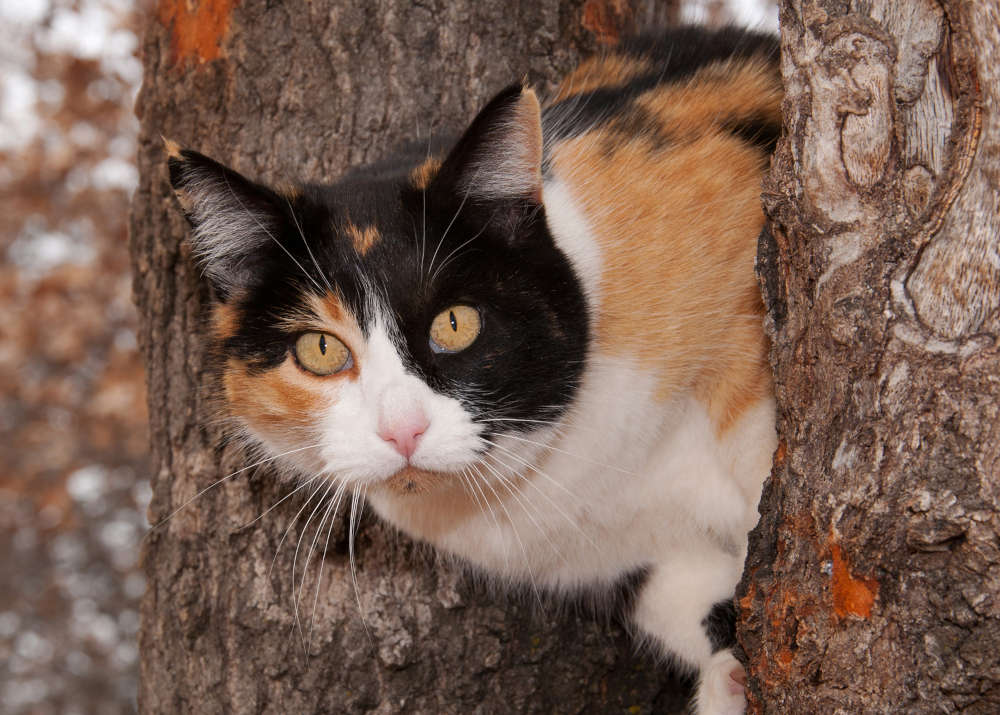
Related: What’s the difference between a calico and a tortie cat
How does the calico coat pattern occur?
There are four base (solid) colors in cats:
- black
- chocolate
- cinnamon
- red
Why not white? Because a cat with a colored and white coat (calico or bi-color) has a gene that switches off color in some parts. The gene responsible is known as piebald or spotting gene (abbreviated to S) and is dominant, as signified by the uppercase S. This means a bi-color or calico cat is genetically a colored cat, but the S gene has switched off the color in certain areas.
Calico cat coat colors
Due to the genetics behind the calico coloration, no two calico cats have the same patterns— including twins.
1. Black with red (orange) and white calico cats
Black with red and white patches is one of the two most common calico cat colorations. A black patch of fur is created when the X chromosome carrying the gene for red fur is inactivated. Similarly, a red patch of fur is created when the X chromosome carrying the gene for black fur is inactivated. This concept can be applied to all color patterns of calico cats.
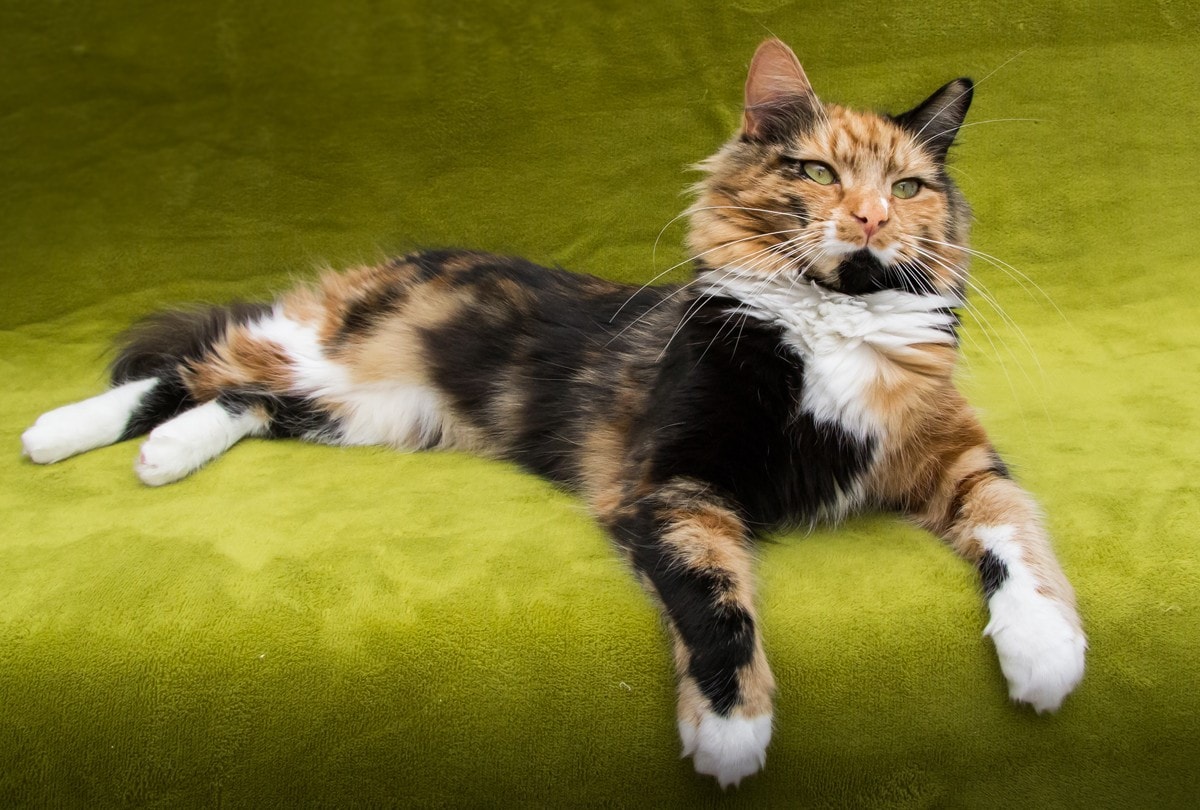

2. Brown with red (orange) and white calico cats
Brown with red and white patches is second of the two most common calico cat colorations.

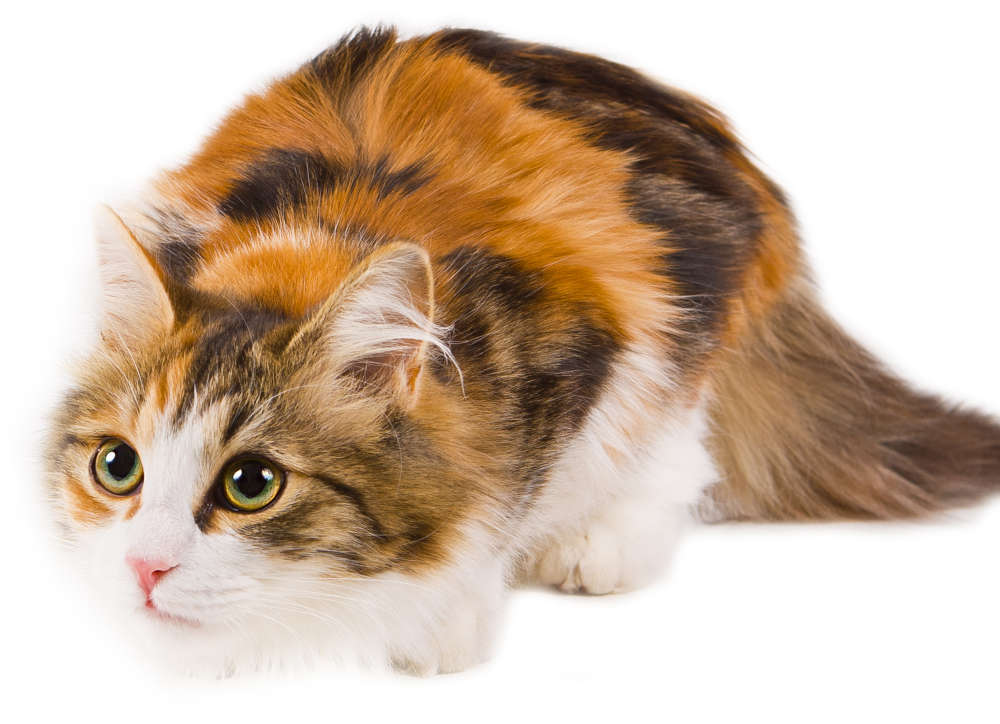
3. Cinnamon with red (orange) and white calico cats
Cinnamon is a warm brown and is produced by a second recessive allele of B, denoted with the symbol (bl). Scientists at the Veterinary Genetics Lab at The University of California at Davis discovered two mutations. One produces chocolate (b), and the other produces cinnamon (bl). Both chocolate and cinnamon are recessive to black (B) and therefore will only show if the cat inherits two copies of the gene.
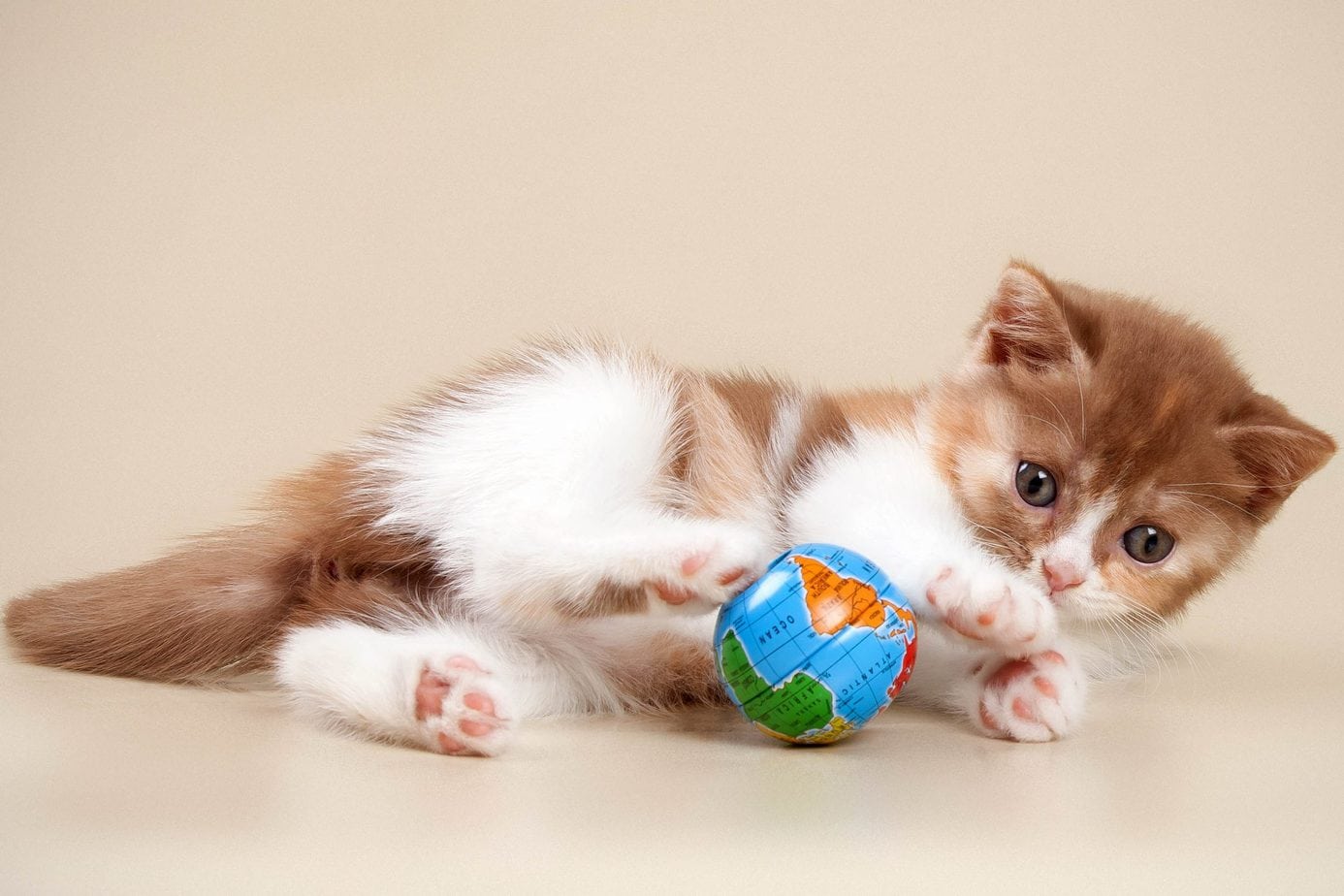
4. Dilute calico cats: gray and cream
The colour density gene controls the amount of pigment in each hair. The amount of pigment determines if coloration will be dense or dilute. This concept can be applied to all calicos with dilute coloration. The gray and cream coloration of a calico cat is due to the dilution of the black and orange genes.

5. Dilute calico cats: lilac and cream
Just like dilution genes can cause coat colors to change from black to gray, it can also cause changes from chocolate to lilac and and orange to cream.

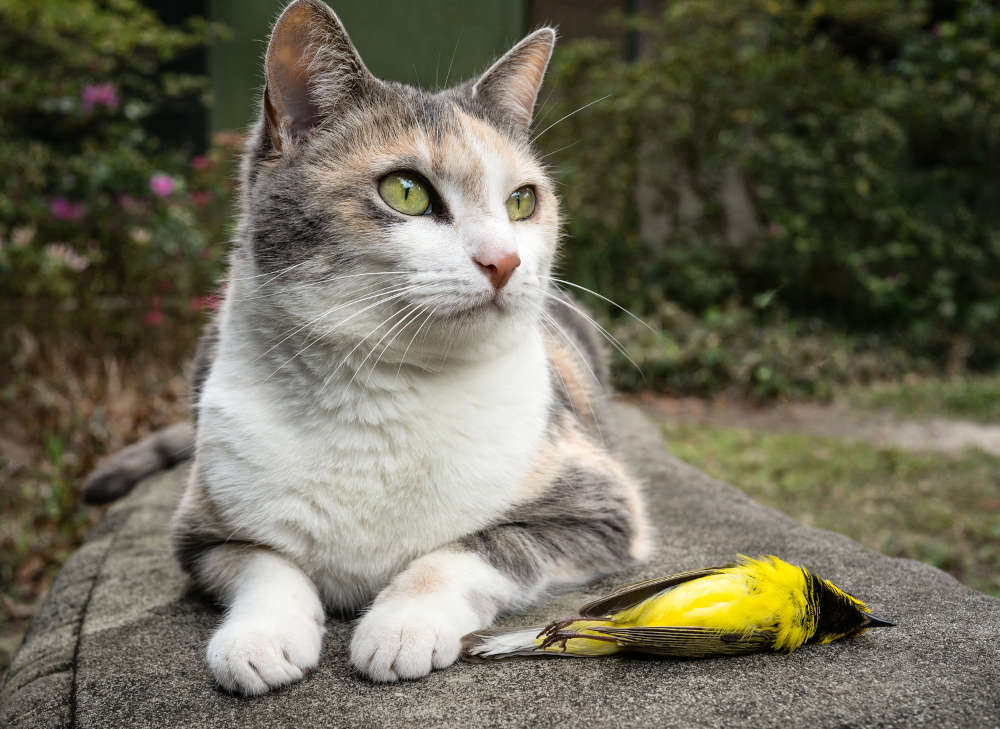

What’s a dilute calico cat?
The colour density gene, or dilute modifier gene, caramelises the coat colour of dilute cats who carry the gene. Some cats carrying the dilution gene display clumping and an uneven distribution of the pigment granules in the hair shaft, producing a dilution of the coat colors which changes black to grey (blue), chocolate to lilac, and orange to cream.
The chart below shows the effects of the dilution and the dilute modifier genes on the coat colours.
| Dense | Dilute | Dilute modifier |
| Black (brown) | Blue (silver) |
Blue-based caramel |
Chocolate |
Lilac |
Lilac-based caramel |
Cinnamon |
Fawn | Fawn-based caramel |
| Red | Cream |
Apricot |
Learn more in our article: Calico cat colors
Male calico cats
Only 1/3,000 calico or tortoiseshell cats are male. To understand why calicos are so rare in male cats, we need a basic understanding of genetics.
The red gene:
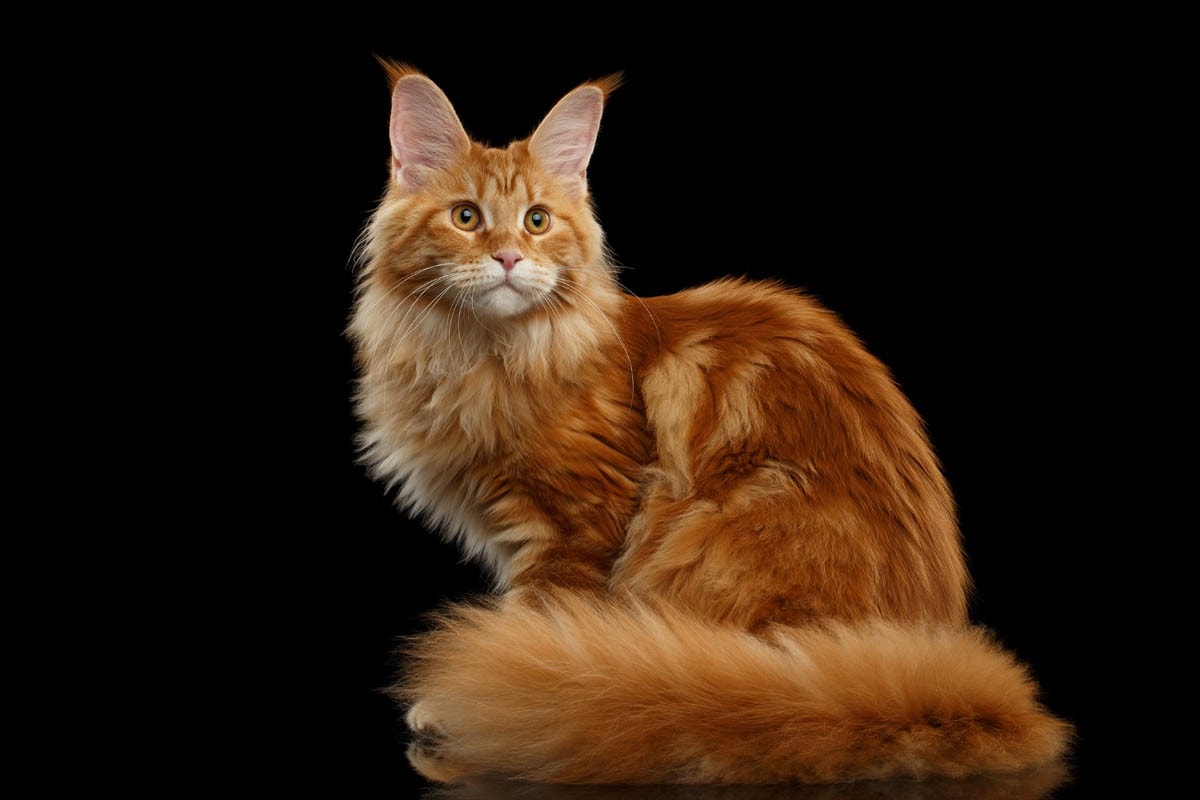
The red (actually known as orange and abbreviated to O) gene is only carried on the X chromosome, which makes it sex-linked. The O gene is dominant (all dominant genes are abbreviated in UPPER CASE, all recessive are lower case). The mother’s eggs only carry an X chromosome, but the male sperm can carry either an X or a Y chromosome. Each cat will inherit an X from its mother and an X or Y from the father.
- Female – XX (X from the mother, X from the father)
- Male – XY (X from the mother, Y from the father)
Interestingly, the faulty gene for hemophilia, a blood clotting disorder, is also sex-linked and found on the X chromosome. Because females have two chromosomes, the good one prevents her from developing the condition, however as the male-only has one X chromosome, he will develop hemophilia. This is the same for colour blindness in human males too.
Female = XX
Male = XY
As the male cat only has one X chromosome, if it carries the O gene (which remember, is dominant), then he will be an orange/red male. If the X chromosome carries the o (non-orange) gene, then the male will be another colour, usually black.
If however, the female kitten inherits both the O and the o (usually black) gene, then because she has two X chromosomes (instead of an X and a Y like the male), both black and red will show making a tortoiseshell cat. If she also inherits the white spotting gene which is responsible for the white coat colour, she will be black, red and have areas of white.
I like to think of the X chromosome as having four sections (or arms), and the shorter and smaller Y only has three. The extra arm of the X chromosome contains additional genes including the O gene. Most genes (except for the sex-linked X and Y) come in two pairs, one from the mother and one from the father. Therefore the male cat only inherits one O gene (which is dominant) from the X chromosome from his mother.
The male cat only needs one copy of the O gene to be red; however, the female needs two copies of the O gene to be red, which is why female ginger cats are seen less often than males.
Female inheritance:
For the female inheriting the red and black genes from both parents, the following may occur:
- O (from mother) O (from father) OO=Ginger cat
- o (from mother) o (from father) oo=Black cat
- O (from mother or father) o (from mother or father) Oo=Tortie cat
Male inheritance:
In the male cat, orange is dominant over black, so if he inherits one O gene and one o (non-orange) gene, he will be orange. So the following will occur:
- O (from the mother) o (from the father Oo=Ginger cat
- 0 (from mother) o (from father) oo=Black cat

Why are females black and orange?
Females carry two X chromosomes (one from each parent), a process known as x-inactivation or Lyonization occurs during fetal development. Every cell has one active and one silenced X chromosome, this includes the melanocytes, which are the cells responsible for hair colour. Therefore the information contained in the active X chromosome is used, and the information in the silenced X chromosome isn’t, this results in both male and females only have one X (active) chromosome per cell.
As this happens in the female carrying both orange and black, the random nature of inactivation means both red and black can appear in the coat depending on which X chromosome has been inactivated in the cell.
Just to complicate things more, the calico cat is essentially a tortoiseshell cat with the addition of the piebald (spotting) gene, this gene turns parts of the coat white by switching off the colours in some areas.
Are calico cats sterile?
We already know that calicos are almost always female cats, and they are as fertile as any other female cat. It is very rare for a male to be calico when he is; he is almost always sterile.
Male calico cats
We know that for a cat to have a calico cat, two X chromosomes are necessary, and the male has one. So how is it possible that some male cats are calico?
- Klinefelter syndrome: The male inherits an extra X chromosome due to an error during meiosis, which is the division of parent cells to produce sex cells.
- Chimerism: Two recently fertilised eggs (XX and XY) that have fused, meaning there is one cat with two distinct sets of DNA. This makes him a chimera.
- Mosaics: One fertilised egg develops into two distinct cell lines due to a random error in a cell of the developing embryo.
Breeds of cat which calico is accepted
The most common type of calico cat is the domestic, or moggy. However, it can be found in some pure breeds of cat too.
- American Bobtail
- American Curl
- American Shorthair
- American Wirehair
- British Shorthair
- Cornish Rex
- Devon Rex
- Exotic
- Japanese Bobtail
- Devon Rex
- German Rex
- Maine Coon
- Manx
- Munchkin
- Norwegian Forest Cat
- Oriental
- Persian
- Scottish Fold
- Scottish Shorthair
- Siberian
- Sphynx
Do calico cats have a personality?
Because calico is a coat pattern and not a breed, each cat is different. Some purebred calico cats may share certain traits. The biggest factor that shapes a cat’s personality is its interaction with its mother, siblings, and humans in the critical first few weeks of life. However, many calico owners describe their felines as very affectionate yet spunky and talkative.
Official state cat of Maryland

The calico has been dotted on by the state of Maryland for many years, assuming the official position as the Maryland State cat on October 1, 2001. According to the State, calico cats were selected to represent them because their orange, black and white colouring resembles other state representatives —the Baltimore oriole and the Baltimore checkerspot butterfly.
Famous calico cats
- Hello Kitty: A fictional cat also known as Kitty White, created by Yuko Shimizu.
- Beckoning cat: A popular Japanese talisman also known as Maneki neko that is usually made from porcelain, wood or plastic. Its literal translation is ‘invitation cat‘, and it represents good luck and fortune to the owner. Its history dates back to the 17th century in the Edo period (1603 – 1867 or 1868).
- Tama: A calico cat (April 29, 1999 – June 22, 2015) who was famous for being a station master at Kishi Station on the Kishigawa Line in Kinokawa.
How do you find a calico cat and how much does a calico cat cost?
Female calico cats aren’t rare and the coloration is seen throughout breeds. It’s likely your local shelter or rescue group has calico cats and kittens in need of homes. If you are seeking a calico cat of a certain breed, some rescues specialise in purebred cats. Some of these organisations include:
- Specialty Pure Bred Cat Rescue
- Saving Fancy Cats
- Purebred Plus Cat Rescue
- Great Lakes Bengal Rescue
- Seattle Persian and Himalayan Rescue
- Siamese Cat Rescue
Because calico cats vary in breed, the cost of adopting or purchasing one can vary greatly. As with any pet, the cost of supplies and care should be considered.
Are there other types of cats similar to calico cats?
Like calico cats, there are other unique colorations of cats due to genetic variations. They differ in the expression of patterns and coloration. These unusual coat patterns are sex-linked and are almost exclusively found in female cats, like the calico:
- Tortoiseshell cats: A tortoiseshell cat is a cat with a coat colour made up of mottled patches of black, chocolate or grey along with red or cream.
- Reverse tortoiseshell: A reverse tortoiseshell cat is a tortoiseshell with more red than black.
- Dilute tortoiseshell: Dilution is a coat colour caused by the aptly named dilute gene which alters the coat colour from black to grey, chocolate to lilac and red to cream.
- Caliby cats: Caliby cats have the coloration of a calico mixed with a tabby—typically areas of orange (red) and brown tabby with white. The name is a mix of calico + tabby = caliby.
- Patched tabby: Also known as torbie, a patched tabby is a cat with random patches of red or cream and a darker colour (black, blue or brown). Patched tabbies can show the mackerel, classic or spotted tabby pattern.
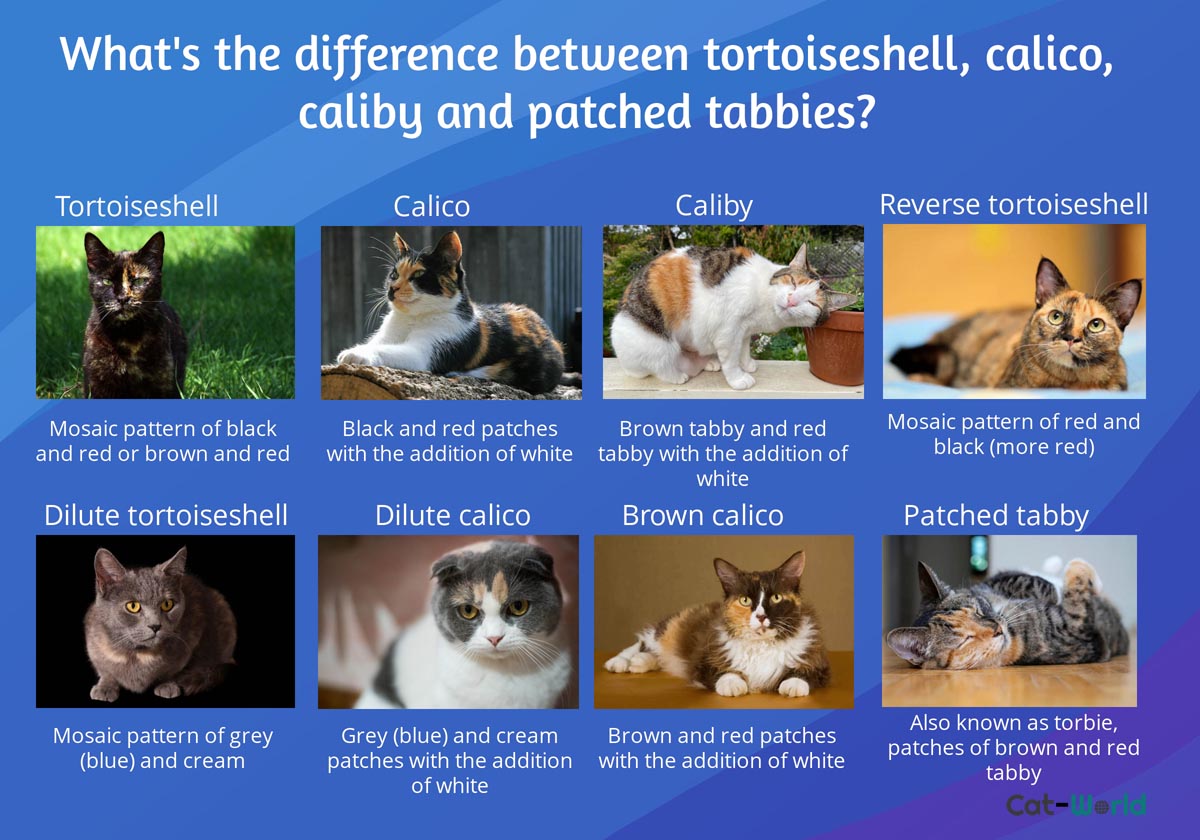
Calico cat FAQ
Where does the name calico come from? Calico is taken from a fabric with the same name which originated in Calicut, (from which the name of the textile came) in southwestern India.
How to pronounce calico kal-ee-koh
Are calico cats talkative? As calico is a colour and not a breed, each calico cat will vary.
What is a calico cat personality? Again, this will vary from cat to cat. A calico cat who has been kept with her mother until ten weeks and had plenty of human contact during this time will generally be friendly and get along with people.
What is the difference between a calico cat and a tortoiseshell (tortie) cat? A tortoiseshell cat is black or brown, and orange and are often mottled, a calico also has patches of white. Read here for more information.


What is the name of a calico cat with tabby markings? A calico-patched tabby and white is called a caliby.

Are calico cats lucky? Calico cats are associated with the Maneki Neko (also referred to as Lucky cats, Money Cats or Beckoning cat) which is placed in the doorway of businesses and homes to bring good luck and fortune.
Do calico cats have health problems? Female calico cats are as healthy as any other coat colour, however, male cats with Klinefelter’s syndrome (XXY) can have health issues associated with their condition.
Are calico cats chimeras? A male calico may be a chimera, meaning the cat carries two distinct genotypes. We know that identical twins occur when one fertilised egg splits and develops into two babies, who share almost identical genetic profiles. In chimera cats, two non-identical fertilised eggs merge into one during early development which results in a cat with two different cell lines in one body.
Are calico cats expensive? No, the calico is no more expensive than any other cat. Male calico cats are rare, however, they do not attract a higher price tag than female calico cats.
In most cases, a purebred calico cat will cost more than a mixed-breed (domestic cat, or moggy) calico. But all purebred cats cost more than mixed-breed cats.
Calico cat lifespan The lifespan of the calico is between 12-14 years for an indoor cat.
Calico cat names
- Amber
- Butterscotch
- Callie
- Cleo
- Harlequin
- Honey
- Kali
- Melody
- Patch
- Patches
- Pixel
- Pumpkin
- Rainbow
- Spice
- Tortie

